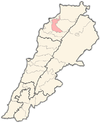Morh Kfarsghab
Morh Kfarsghab
مرح كفرصغاب | |
|---|---|
City | |
UTC+3 (EEST) | |
| Postal code | 1304 |
| Dialing code | +961 - 6 |
Morh Kfarsghab ( known also as Morh Kfar Sghab, Murh Kafarsghab or Mrah Kfarseghab;
Murh Kfarsghab is the winter dwellings of the people of the mountain village of
Etymology
Morh (
As cattle breeding was never a main source of income for Kfarsghab, it is possible that Morh Kfarsghab was used in winter for the Mullberry
For the local people, Morh Kfarsghab is called sahil (
History
Geography
Morh Kfarsghab, the winter village, is located on the north-western slope of the Joueit valley separating Miziara from Bnachii. On average, it sits at 280 meters above sea levelgives an estimation which is slightly higher (298 meters) than measured average altitude (280 meters). A written document mentioning Morh Kfarsghab is dated to October / November 1748 AD (Thu'l-Qa'dah 1161 Hijri).[2]
Climate
Morh Kfarsghab is a typical Mediterranean plain settlement. There are four seasons, with winters being mild with moderate to heavy rainfall while summers are hot, arid and dry. The highest average temperature is in August at 86 °F (30 °C) while the lowest average temperature is in January at 46 °F (8 °C). However, summer temperatures can top 104 °F (40 °C), and winter temperatures can drop below 35 °F (2 °C).[3] Total yearly precipitation is in the range of 33 inches (810 mm), with the heaviest occurring from late November to early April. Rainfall is exceptional between mid June and mid September.
| Climate data for Morh Kfarsghab, Lebanon | |||||||||||||
|---|---|---|---|---|---|---|---|---|---|---|---|---|---|
| Month | Jan | Feb | Mar | Apr | May | Jun | Jul | Aug | Sep | Oct | Nov | Dec | Year |
| Mean daily maximum °F (°C) | 61 (16) |
61 (16) |
66 (19) |
71 (22) |
77 (25) |
80 (27) |
84 (29) |
86 (30) |
84 (29) |
80 (27) |
71 (22) |
64 (18) |
74 (23) |
| Mean daily minimum °F (°C) | 46 (8) |
48 (9) |
50 (10) |
55 (13) |
61 (16) |
66 (19) |
71 (22) |
73 (23) |
68 (20) |
62 (17) |
55 (13) |
50 (10) |
59 (15) |
| Source: Kfarsghab.net[4] | |||||||||||||
Economy
Agriculture
The major issue is scarcity of water. Agricultural activities privileged crops that do not need irrigation, such as
The land owned by the Kfarsghab people extends on a large area in the
Notes
- ^ Wardini, Elie (June 1994). "A project proposal". A Glimpse of Yesterday - A Typology of Regional Variation and Cultural Continuity in Lebanese Place-Names. Department of East European and Oriental Studies - University of Oslo. Retrieved 2007-10-30.
- ^ "Title of Property of Morh Kfarsghab". Archived from the original on 2016-03-03. Retrieved 2007-10-30.
- ^ On Friday, January 11, 2008, the Lebanese newspaper Daily Star, reported that temperatures in the region of Morh Kfarsghab dropped to -4 °C. Cited by Zgharta.com, Zgharta.com, last retrieved on 2 August 2008
- ^ "Geography of Kfarsghab". Kfarsghab.net. 2006. Archived from the original on 2016-03-25. Retrieved 2008-06-04.
- ^ Eat the seasons - grapes Archived 2008-05-16 at the Wayback Machine, last retrieved August 8, 2008.
- ^ An article on Kfarsghab land owning by the Lebanese newspaper Daily Star dated of 10 June 2004 by Adnan Al Ghoul, Kfar Sghab: Village stays close to its expatriate sons and daughters - Residents are so close-knit they don't sell land to strangers, last retrieved on August 4, 2008.
- ^ Loubnanouna.org citing an article by Gregory Katz of the Houston Chronicle of 13 February 2007 Archived 18 February 2007 at the Wayback Machine, last retrieved August 5, 2008
- ^ Fita page on Lebanon - Agriculture chapter, last accessed on August 6, 2008.
- ^ Countrystudies - U.S. Library of Congress, last accessed on August 6, 2008.
External links
- (in English and French) kfarsghab.net, useful information
- (in English) The Australian Kfarsghabian community website
- (in English) The American Kfarsghabian community website
- Ehden Family Tree

